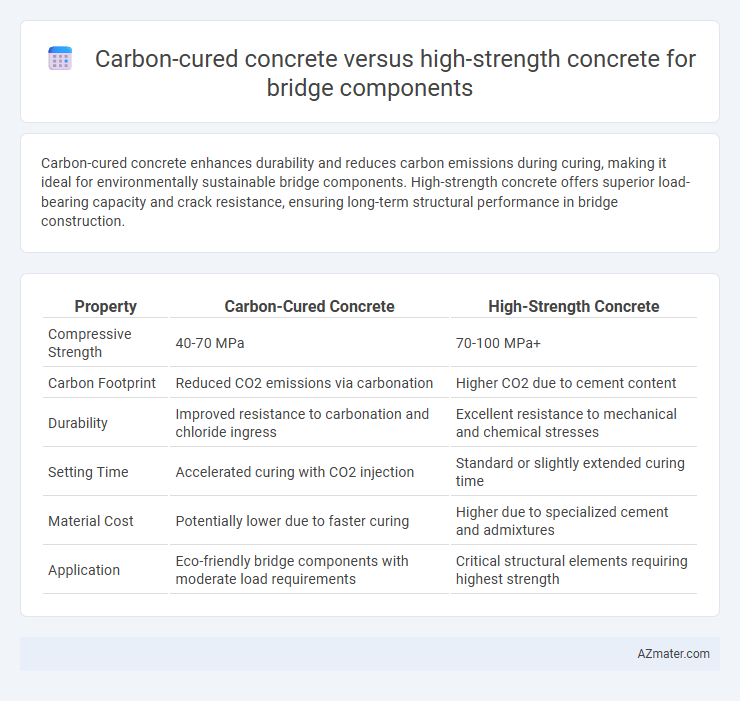Carbon-cured concrete enhances durability and reduces carbon emissions during curing, making it ideal for environmentally sustainable bridge components. High-strength concrete offers superior load-bearing capacity and crack resistance, ensuring long-term structural performance in bridge construction.
Table of Comparison
| Property | Carbon-Cured Concrete | High-Strength Concrete |
|---|---|---|
| Compressive Strength | 40-70 MPa | 70-100 MPa+ |
| Carbon Footprint | Reduced CO2 emissions via carbonation | Higher CO2 due to cement content |
| Durability | Improved resistance to carbonation and chloride ingress | Excellent resistance to mechanical and chemical stresses |
| Setting Time | Accelerated curing with CO2 injection | Standard or slightly extended curing time |
| Material Cost | Potentially lower due to faster curing | Higher due to specialized cement and admixtures |
| Application | Eco-friendly bridge components with moderate load requirements | Critical structural elements requiring highest strength |
Introduction to Bridge Concrete Technologies
Carbon-cured concrete offers enhanced durability and accelerated curing times by utilizing CO2 sequestration, making it a sustainable alternative for bridge components. High-strength concrete provides superior load-bearing capacity and improved resistance to environmental stressors, essential for critical structural elements in bridge construction. Selection between these technologies depends on factors such as environmental impact, strength requirements, and long-term performance in bridge design.
Overview of Carbon-Cured Concrete
Carbon-cured concrete utilizes carbon dioxide sequestration during the curing process, enhancing strength and durability while reducing carbon footprint by permanently trapping CO2. This innovative curing method accelerates hydration, resulting in improved early age strength compared to traditional high-strength concrete, which relies on mix design and additives. The carbon sequestration capability of carbon-cured concrete aligns with sustainable construction practices, making it an environmentally responsible choice for bridge components.
Understanding High-Strength Concrete
High-strength concrete (HSC) for bridge components typically exhibits compressive strengths exceeding 6,000 psi, providing enhanced durability and load-bearing capacity critical for infrastructure longevity. Its dense microstructure reduces permeability, improving resistance to environmental factors such as freeze-thaw cycles and chloride-induced corrosion, which are common challenges in bridge environments. The optimized mix design of HSC, often incorporating supplementary cementitious materials like fly ash or silica fume, enhances mechanical properties and ensures structural integrity under dynamic loads.
Key Differences in Composition
Carbon-cured concrete incorporates activated carbon additives that enhance carbonation reactions, improving durability and reducing permeability in bridge components. High-strength concrete relies on a low water-to-cement ratio and high-quality cementitious materials like silica fume and fly ash to achieve compressive strengths typically above 6000 psi. The primary compositional distinction lies in carbon-cured concrete's use of carbon-based curing techniques to optimize microstructure versus high-strength concrete's emphasis on mixture design for maximum load-bearing capacity.
Mechanical Properties Comparison
Carbon-cured concrete exhibits enhanced tensile strength and improved durability due to accelerated carbonation, which increases density and reduces porosity compared to traditional methods. High-strength concrete typically offers superior compressive strength ranging from 50 to 100 MPa, making it ideal for load-bearing bridge components, but may have lower resistance to crack propagation. The mechanical properties of carbon-cured concrete, including better flexural strength and increased resistance to chemical attack, present a competitive advantage in bridge applications where longevity and structural resilience are critical.
Durability and Longevity Analysis
Carbon-cured concrete exhibits enhanced durability through accelerated carbonation, which increases surface hardness and reduces permeability, leading to improved resistance against chloride ingress and sulfate attack in bridge components. High-strength concrete offers superior mechanical performance with reduced porosity, minimizing micro-crack formation and enhancing long-term structural integrity under cyclic loading and aggressive environmental conditions. Comparative studies indicate carbon-cured concrete provides faster early-age strength gain and corrosion resistance, whereas high-strength concrete delivers sustained load-bearing capacity and durability over extended service life in bridge applications.
Environmental Impact Assessment
Carbon-cured concrete reduces carbon dioxide emissions by absorbing CO2 during curing, significantly lowering the carbon footprint compared to traditional high-strength concrete, which relies heavily on cement with high embodied carbon. Life cycle assessments reveal that carbon-cured concrete can decrease greenhouse gas emissions by up to 30%, making it a more sustainable choice for bridge components. High-strength concrete, while offering superior mechanical performance, typically results in greater environmental impact due to higher clinker content and energy-intensive production processes.
Cost and Economic Considerations
Carbon-cured concrete offers significant cost savings in bridge components by reducing curing time and energy consumption compared to traditional high-strength concrete, which typically requires longer curing periods and more energy input. While high-strength concrete delivers superior structural performance, its higher material and curing costs can lead to increased overall project expenses. Evaluating lifecycle costs, carbon-cured concrete may present a more economical option for large-scale bridge projects by balancing adequate performance with lower production and maintenance costs.
Performance in Real-World Bridge Applications
Carbon-cured concrete exhibits enhanced durability and improved resistance to carbonation and chloride ingress, making it ideal for bridge components exposed to harsh environmental conditions. High-strength concrete provides superior compressive strength and load-bearing capacity, enabling the construction of slender and lightweight bridge elements without compromising structural integrity. Real-world bridge applications show carbon-cured concrete extending service life by reducing corrosion risks, while high-strength concrete ensures safety and performance under heavy traffic loads and dynamic stresses.
Future Trends in Bridge Concrete Solutions
Carbon-cured concrete is gaining attention for bridge components due to its accelerated curing process and enhanced durability through CO2 sequestration, which supports sustainability goals in infrastructure development. High-strength concrete remains essential for load-bearing elements, offering superior compressive strength and long-term performance under heavy traffic conditions. Emerging trends emphasize hybrid approaches combining carbon curing techniques with advanced high-strength formulations to optimize environmental impact and structural resilience in future bridge construction.

Infographic: Carbon-cured concrete vs High-strength concrete for Bridge component
 azmater.com
azmater.com